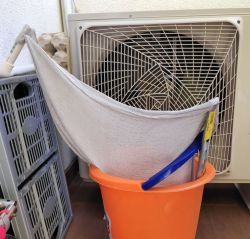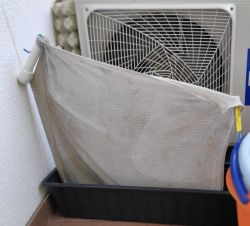Hi.
I have air conditioning installed in the block. Outdoor unit on the balcony, drainage to the bucket. (2nd floor, there is no question of putting the pipe outside the balcony, there are no gutters within reach, currently no possibility of draining (pumping out) the condensate to the kitchen or bathroom (maybe someday generalce you could run a tube in the bathroom floor). Simply at this point, the bucket is the only (known to me) way out.
I like to combine and I decided that since the outdoor unit is blowing with hot air, I found that I would check the evaporation efficiency. Briefly writing I did as shown in the picture below: I put the end of a tetras diaper into the outlet of the condensate tube (it perfectly collects moisture when wiped) and hung it ~ 50 cm in front of the air outlet with the unit. outside, putting the rest in the bucket. I admit that I have not yet measured the efficiency of this solution (due to lack of time), but the fact is that the water in the bucket arrives much slower. Not only that - for example yesterday morning there was ~ 4 cm of water in the bucket, the air conditioning was not turned on all day (there was no need to do so) and the bucket was dry until the evening.
And here I have questions for professionals or imaginative guests (or both ): Are there any condensate evaporation systems used in professional air conditioning systems? (I've heard of sputtering but missed evaporation.)
): Are there any condensate evaporation systems used in professional air conditioning systems? (I've heard of sputtering but missed evaporation.)
If I wanted to make a slightly better and more durable version of such an evaporator, do you have ideas how to possibly make it and from what material?
At the moment, I have an idea to hang this tetra in such a way as to maximize its surface. wavy like a curtain (vertically) or in some way (e.g. on strings) horizontally. horizontal folds should be better as they will extend the vertical water path giving more time to evaporate.
Please note that I do not want to use the outdoor unit cooler for water evaporation / disposal. I don't want to "interfere" with it.
What do you think about such a "screwed up" idea? .
.

I have air conditioning installed in the block. Outdoor unit on the balcony, drainage to the bucket. (2nd floor, there is no question of putting the pipe outside the balcony, there are no gutters within reach, currently no possibility of draining (pumping out) the condensate to the kitchen or bathroom (maybe someday generalce you could run a tube in the bathroom floor). Simply at this point, the bucket is the only (known to me) way out.
I like to combine and I decided that since the outdoor unit is blowing with hot air, I found that I would check the evaporation efficiency. Briefly writing I did as shown in the picture below: I put the end of a tetras diaper into the outlet of the condensate tube (it perfectly collects moisture when wiped) and hung it ~ 50 cm in front of the air outlet with the unit. outside, putting the rest in the bucket. I admit that I have not yet measured the efficiency of this solution (due to lack of time), but the fact is that the water in the bucket arrives much slower. Not only that - for example yesterday morning there was ~ 4 cm of water in the bucket, the air conditioning was not turned on all day (there was no need to do so) and the bucket was dry until the evening.
And here I have questions for professionals or imaginative guests (or both
If I wanted to make a slightly better and more durable version of such an evaporator, do you have ideas how to possibly make it and from what material?
At the moment, I have an idea to hang this tetra in such a way as to maximize its surface. wavy like a curtain (vertically) or in some way (e.g. on strings) horizontally. horizontal folds should be better as they will extend the vertical water path giving more time to evaporate.
Please note that I do not want to use the outdoor unit cooler for water evaporation / disposal. I don't want to "interfere" with it.
What do you think about such a "screwed up" idea?




